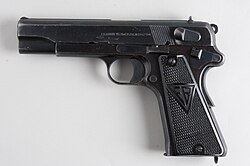Top Qs
Timeline
Chat
Perspective
German designations of foreign firearms in World War II
From Wikipedia, the free encyclopedia
Remove ads
The German designations of foreign firearms in World War II is a list of known foreign firearms and equipment compiled by the German armed forces before World War II.
This article has multiple issues. Please help improve it or discuss these issues on the talk page. (Learn how and when to remove these messages)
|

Remove ads
Purpose
The purpose of these lists are threefold:
- Provide a list of German designations for foreign firearms.
- Correlate German weapons designations with their associated wiki pages.
- Provide a reference for captured foreign firearms in German service during WWII.
Background
Summarize
Perspective
Before the war began the German armed forces Heereswaffenamt compiled a list of known foreign equipment and assigned a unique number to each weapon. These weapons were called Fremdgerät or Beutegerät ("foreign device" or "captured device") and their technical details were recorded in a fourteen-volume set that was periodically updated. The Germans also captured large amounts of foreign equipment during WWII (for example, over 11 million rifles by the end of 1944[1]) that they tested and cataloged using the same system. The Germans sometimes referred to these weapons as Kriegsbeute ("war booty") and the Fremdgerät numbers are sometimes referred to as Beutenummern ("booty numbers").

The format for these designations follow this pattern. The German designation of the type of firearm, model/year number or unique identification number and lastly its country code. In the first example there's a carbine and it has been assigned a unique identification number and it is French. In the second example there's a Pistol with a model/year designation and it is Austrian. In practice common model designations don't always share the same ID numbers. Because a Mauser model 98 could be produced in different countries, have different calibers and have a different model/year or unique identification number for each country. Also while a Mauser model 98 from different countries may be able to fire the same ammunition that doesn't mean their parts are compatible or interchangeable. Lastly unique numbers with / mean the weapon is a sub-variant. For a list of German military terms see Glossary of German military terms.
Remove ads
Weapon designations
Country designations

Remove ads
Sort by Letter Code/Country
Summarize
Perspective
- Note: This will not include anti-tank weapons and rifle grenade launchers
(a)/United States
(b)/Belgium
(d)/Denmark
(e)/United Kingdom (British Empire)
(f)/France
(g)/Greece
(h)/Netherlands
(i)/Italy
(j)/Yugoslavia
(n)/Norway
(ö)/Austria
(p)/Poland
(r)/Soviet Union
(t)/Czechoslovakia
(u)/Hungary
Remove ads
Sort by weapon type
Pistols/Revolvers
Submachine guns
Rifles
Carbines
Light machine guns
Heavy machine guns
Tank machine guns
Aircraft/Ant-Aircraft machine guns
Rifle grenade launchers
Anti-tank weapons
Remove ads
See also
- German designations of foreign artillery in World War II
- Specifications for World War II infantry weapons
- List of secondary and special-issue World War II infantry weapons
- Lists of World War II military equipment
- List of World War II weapons
- List of prototype World War II infantry weapons
List of firearms
Remove ads
Notes
- Name for the ZK-383 after it was adopted by Slovak Republic.
- Mauser-pattern carbine for Chile, chambered for 8mm Mauser instead of the Chilean 7mm.[16]
- This is the Gewehr 33/40 made in 1941 and 1942, during the German occupation of Czechoslovakia for the Wehrmacht (German armed forces), especially for use in the Gebirgsjäger (German mountain troops).
- Could use German-made 7.92mm Mauser ammunition.
- Could not use German-made 7.92mm Mauser ammunition.
- Called the Discharger Cup, 2.5-in., No.1, Mk. I in British Service.
- Called the Discharger Cup, 2.5-in., No.2, Mk. I in British Service.
- Equipped with a Cup Discharger Mk I.
- Spanish-made licensed copy of the Smith & Wesson Military & Police.
- Also called the MAS-36.
- Weapon features:
- Barrel has 4 locking pins
- Cap lock on the left side
- Cam gear has 6 teeth
- Trigger consists of 2 parts
- Weapon features:
- Barrel has 5 locking pins
- Cap lock on the left side
- Cam gear has 18 teeth
- Trigger consists of 3 parts
- Weapon features:
- Barrel has 5 locking pins
- Cap lock on the left side
- Cam gear has 18 teeth
- Trigger consists of 3 parts
- Long water jacket
- Foldable handles
- Weapon features:
- Barrel has 5 locking pins
- Cap lock on the left side
- Cam gear has 18 teeth
- Trigger consists of 3 parts
- Short water jacket
- Foldable handles
- The gun model is the FN-Browning M.36 No.3.
Remove ads
References
External links
Wikiwand - on
Seamless Wikipedia browsing. On steroids.
Remove ads


















